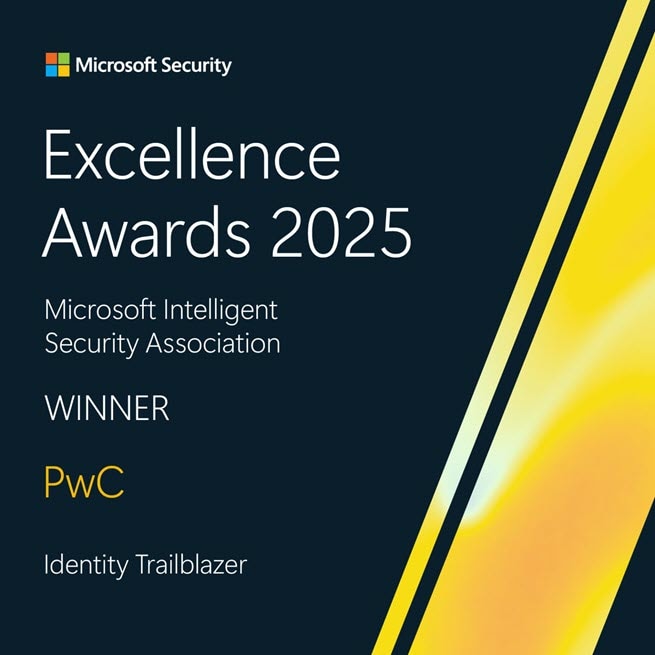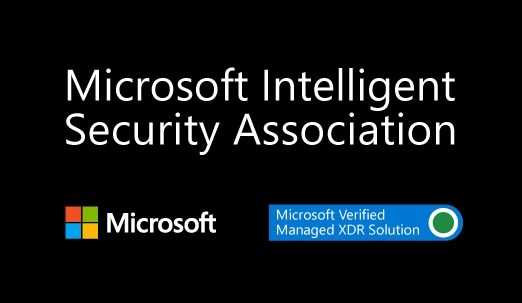Say hello to a more secure future
Elevated threats and regulatory scrutiny mean cybersecurity has never been a higher priority. Most business and security leaders agree: cybersecurity and data protection risks are on the rise and will likely continue to evolve with emerging technology. Preparing your business to meet increasingly complex and unexpected risks can be overwhelming, but it doesn’t have to be.
PwC’s deep industry experience and Microsoft’s secure technology empower businesses to confidently build trust in your tomorrow. Together, we’ll help solve your most complex business challenges.
PwC wins 2025 Microsoft Identity Trailblazer Award
PwC has been recognized as the 2025 Microsoft Security Excellence Awards Identity Trailblazer for our leadership in deploying Microsoft Entra ID solutions and helping clients modernize identity, secure access, and reduce cyber risk.

Microsoft Copilot for Security
Addressing cybersecurity challenges with an advanced AI solution
Copilot for Security helps organizations adapt swiftly to ever-evolving cyber threats, identifying, responding and neutralizing them rapidly to keep operations secure. PwC offers a two-step approach for Copilot for Security.
- The readiness assessment helps organizations prepare for a Copilot for Security rollout by identifying requirements and opportunities for enhancements and providing recommendations to best leverage the technology stack.
- The implementation phase manages the integration of Copilot for Security to existing technology stack including creation of prompt books, skills, custom plugins, updates to standard operating procedures, and assisting with improvement of detection engineering and indicators of compromise processes.
Using Copilot for Security, PwC can offer your organization a way to streamline SOC operations and increase efficiency through advanced automation, helping to effectively combat cyber threats and enhance your security posture.
Make giant leaps with generative AI
PwC is honored to partner with Microsoft to bring Copilot for Security to our joint customers. With Copilot for Security our customers can swiftly identify, investigate, and resolve threats by harnessing the potential of generative AI.
Building on our recent investment to expand and scale our AI offerings, we're excited to team with Microsoft on bringing Copilot for Security to our joint customers, augmenting their ability to predict - prevent - and rapidly respond to security threats. This will help empower all of our customers and provide new opportunities leveraging the responsible use of generative AI.
Quick reads on critical cybersecurity topics
In five minutes, get the latest on topics like portfolio rationalization, third party risk, and security incident and event management.
How PwC and Microsoft can help you simplify cyber
Case study: How a Fortune 500 company shut down fraud, bribery and corruption
Global fraud, bribery and corruption is a $4 trillion per year problem. PwC’s Risk Command, powered by Microsoft Sentinel helped identify risks that previously may have gone undetected. Explore how a global company made risk and compliance their competitive advantage.

Be cyber-ready with PwC’s security solutions powered by Microsoft
Security demystified
Increase cyber readiness while reducing risk and complexity.

Incident Response goes beyond addressing technical infrastructure and removing threat actors. It also involves crisis management, collaboration, and communication. PwC and Microsoft can help address the diverse and complex problems that arise during and after a breach. We can work closely with you to help remediate and update your processes and systems, enhancing the ability to prevent or detect future incidents.
Read about our integrated IR solution
Watch to learn more about IR

Too many security tools can bring more complexity and inhibit risk reduction activities. We can simplify your portfolio—gathering information about your existing applications and conducting scenario analysis to identify gaps in your technology. We’ll work closely with you to rationalize your security stack and improve your security capabilities—reducing the cost and complexity of your cybersecurity program while supporting your risk reduction goals.
Simplify your security stack: Watch

Traditional security incident and event management (SIEM) solutions cannot keep pace with the increasing volume and complexity of today’s cyber threats. Our Threat Detection & Response (TDR) services range from designing and building cloud-native, next-generation security operation centers (SOC), SIEM and extended detection and response (XDR) operating models to ongoing operations, 24/7. With Rapid Replacement, we seamlessly migrate your existing SIEM and SOC to Microsoft Sentinel and Microsoft 365 Defender XDR. Rapid Release goes one step further to build a full-stack TDR platform that supports the transition to a hybrid on- or off-site managed service with continuous alert monitoring and response.
Centralize threat monitoring: Watch

The convergence of information technology (IT), operational technology (OT) and the Internet of Things (IoT) creates a complex and disconnected digital ecosystem that is difficult for providers to integrate and secure. Our Microsoft Defender for IoT services combine PwC’s OT cybersecurity capabilities with Microsoft’s technology to help companies get better visibility into their OT networks and data. We can help your organization quickly identify OT assets, identify threats within your environment, improve resilience and keep your operations moving forward.

An optimized supply chain is designed to meet evolving customer demands and create more business opportunities—while streamlining costs and efficiencies. Our cloud-based solutions include continuous security and centralized management to help simplify the process of monitoring, updating and identifying threats, using analytics to help discover powerful insights. We can design an intelligent and interconnected digital supply chain that’s transparent and secure across your organization—from operations, to marketing, to fulfillment.
Enhance network intelligence: Deep dive
Compliance, met
Satisfy the changing demands of compliance requirements and regulations with confidence.

Valuable information needs protection in all stages of its lifecycle. We create, store, use, archive and delete information—and let you know exactly where it lives. From information protection, to records management, to knowledge sharing and secure collaboration—we can make the most of your information in a more secure and user-friendly environment.

Growing information assets requires increased visibility into where your sensitive data resides. We perform a current state assessment to identify sensitive data management gaps that will help inform process enhancements such as defining the governance structure, roles and responsibilities in your organization. We can classify, protect and govern your data by formalizing the processes, controls and metrics that support your information security strategy.

Data in the cloud isn’t always secure. Get full control over your data by securing it in an isolated environment that allows users to analyze it without exposing it to malicious actors. We’ve unleashed new opportunities for collaboration that can reduce your attack surface—so you can shift your focus from worrying about protecting your business to spending more time leading it.

Every company within the Department of Defense supply chain with access to certain data types such as federal contract information and Controlled Unclassified Information—not just the defense industrial base—will be required to become Cybersecurity Maturity Model Certification (CMMC) certified. We’ll help establish baseline security measures and create customized recommendations for your business with compliance-by-design, so you can bring your cybersecurity controls up to the new standard.

As more businesses continue to utilize the cloud, replacing an aging identity management tool is needed so you can help govern your identity and access lifecycles, as well as secure privileged access for your administrators.
Microsoft Entra ID Governance helps focus on answering the following questions:
- Who has access and what do they have access to?
- How is that access being used?
- Is that access being controlled?
- Can I assess that the controls are operating?
PwC's identity and access management services can help across all capability phases, from helping to assess your existing capabilities deployed in SAP IDM and strategize and plan your target future state and vision with Microsoft Entra ID Governance. PwC can also support and operate the environment as a managed service after the go live.

Insider risk is on the rise, and preventing it is a critical component of cybersecurity that requires attention from all stakeholders. We can build insider risk prevention detection and response capabilities from the ground up or complement your existing environment. Accelerate your insider risk program to help reduce risk against your most sensitive assets and detect risky behavior across your organization’s systems.
Reduce insider risk: Deep dive

Security incidents have exploited software vulnerabilities and insufficient identity controls to gain access to valuable data or disrupt critical business operations. Organizations are exploring modern comprehensive zero trust solutions to effectively protect against today’s cyber threats. PwC’s Microsoft Zero Trust is a three-phased approach focused on building a secure foundation around users and devices, enabling conditional access and applying segmentation to protect your company’s information.
PwC has collaborated with Microsoft on Entra Private Access and Internet Access products, contributing to product enhancements and gaining experience with the new products. With industry-leading experience in Cybersecurity and Zero Trust, PwC can strategize, design, implement, and operationalize Zero Trust solutions tailored to your specific business needs using Microsoft's Entra Private Access and Internet Access products.
Build a secure foundation: Quick read

Devices, apps, online services and networks are at risk when your credentials are used or stolen. Passwordless technology uses authentication factors, biometrics and other mechanisms in lieu of passwords to help protect your personal and enterprise assets from unauthorized users. We combine device trust with risk controls to help reduce threats, so you can be certain that your accounts are safe from malicious actors.

PwC named member of The Microsoft Intelligent Security Association
"The security relationship between Microsoft and PwC has helped our joint customers better understand their IT environments, respond to threats and adapt to the changing security landscape. We are thrilled that PwC has achieved Microsoft verified Managed XDR solution status – we look forward to expanding our alliance even further through the MISA program."
-Mandana Javaheri, Microsoft Global Senior Director, Cybersecurity Business Development
Reimagine Cybersecurity
PwC achieves Microsoft verified Managed XDR solution status with Threat Detection and Response
Have confidence in who you’re working with
PwC & Microsoft Perspectives
Quick five-minute reads to catch you up on the latest security topics

Microsoft recognizes PwC as a 2025 Partner of the Year
PwC is reimagining the possible, creating solutions on Microsoft tech, that untangle complex world problems. Together, PwC and Microsoft are empowering the world to achieve more in industry and beyond.
Contact us
Scott Sikorski
Principal, Cyber, Data & Tech Risk, PwC US









